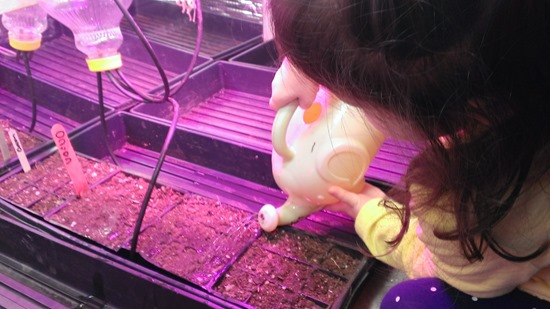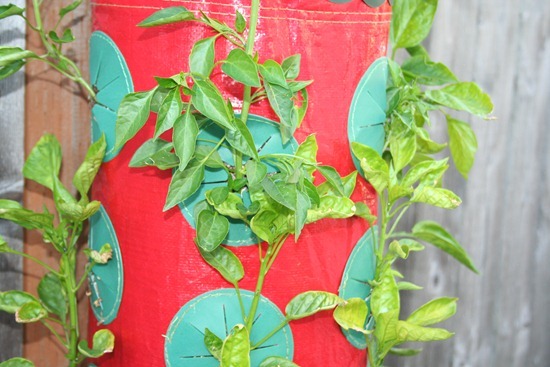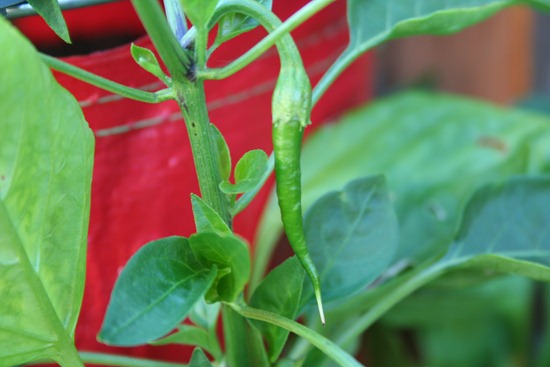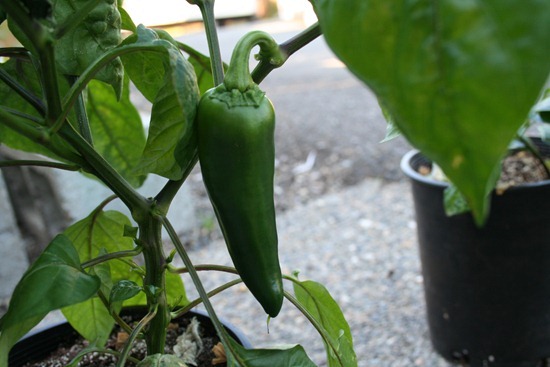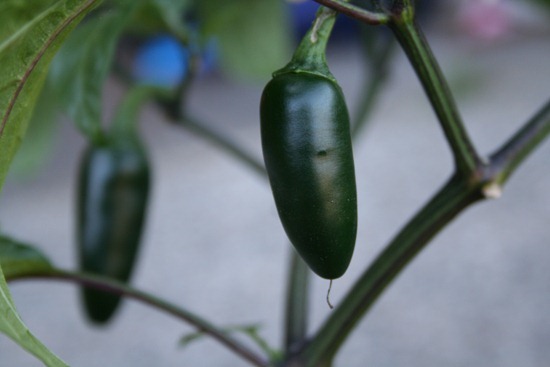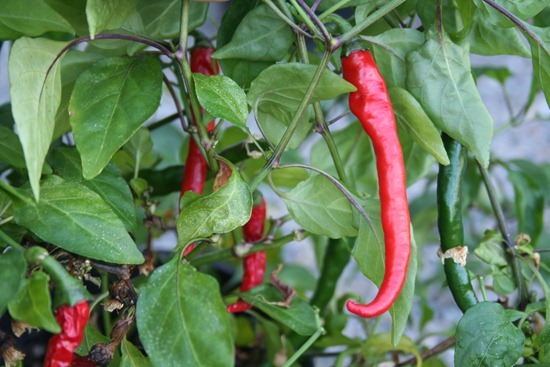When to start garden seeds indoors: Seed starting calculator
8.2 years ago cheap, indoor growbox, indoor seed starting, seedling, seeds

When you start seeds indoors in a vegetable garden, it can be difficult getting your schedule down to ensure that start your vegetable seeds with enough lead time that they are mature enough to venture outside but also not so large they take over your growing area.
Personally this has been a difficult part for me where I am really good getting the early vegetables started on time (onions, peppers, tomatoes) but when it comes to the later plants and/or second/third plantings is where I begin to get forgetful. Over the years I have come across a couple of great tools to make this easier that I thought I would share.
No matter which option you choose to start garden seeds indoors you will need to determine an important date, your last frost date. There are many sites/tables out there that will give an estimate I actually have a couple posts on the subject but at the moment my favorite site that makes this very easy is WeatherSpark, it uses historical data with great visuals to easily determine when the best probability of picking the right date. Here you can take a look at this historical data and make your call of what date you think will be safe.
1. Create a garden schedule. Just by figuring out your last frost date and doing a little math (Excel works great for this) you can determine the optimal seed starting dates and even get a general idea of when your plants should be ready for transplanting. What I love about this technique is you can tweak it each year as things worked well (or not so well) in previous years to get the schedule finely tuned to your particular garden and the micro-climates within it.
In addition knowing an estimate of when these plants will be venturing out in the wild can assist in your space planning for your seeding area as well as having a reality check if you see your peppers will be ready to be transplanted in March when it doesn’t get above freezing until mid-June.
Here is my schedule for starting seeds indoors my area and estimated last frost date (April 20th), though sure everyone that is reading this will not have the same date as mine so thanks to my infinite nerdiness I made the following table so you can adjust the “Last Frost Date” to yours and see how my schedule would look in your area.
| Last Frost Date: |
| Vegetable Name | Seed Start Date | Estimated Transplant Date |
Estimated Harvest Date |
| Celery | 1/19/2013 | 3/18/2013 | 4/24/2013 |
| Onion | 1/19/2013 | 3/25/2013 | 5/24/2013 |
| Leeks | 1/19/2013 | 3/21/2013 | 6/3/2013 |
| Kale | 1/26/2013 | 3/7/2013 | 3/22/2013 |
| Artichoke | 1/31/2013 | 4/27/2013 | 6/20/2013 |
| Kohlrabi | 2/9/2013 | 3/15/2013 | 4/5/2013 |
| Pak Choi | 2/9/2013 | 3/6/2013 | 4/10/2013 |
| Parsley | 2/8/2013 | 4/6/2013 | 4/24/2013 |
| Lettuce | 2/9/2013 | 3/6/2013 | 4/5/2013 |
| Broccoli | 2/9/2013 | 3/15/2013 | 4/20/2013 |
| Pepper – Jalapeno | 2/9/2013 | 4/28/2013 | 4/25/2013 |
| Pepper – Bell | 2/9/2013 | 5/4/2013 | 4/25/2013 |
| Swiss Chard | 2/16/2013 | 3/20/2013 | 4/7/2013 |
| Cabbage | 2/16/2013 | 3/31/2013 | 5/7/2013 |
| Brussel Sprouts | 2/22/2013 | 3/31/2013 | 5/23/2013 |
| Collards | 3/2/2013 | 3/24/2013 | 5/1/2013 |
| Tomato | 3/2/2013 | 5/4/2013 | 5/21/2013 |
| Spinach | 3/9/2013 | 4/23/2013 | |
| Peas | 3/9/2013 | 5/13/2013 | |
| Turnips | 3/9/2013 | 5/8/2013 | |
| Watermelon | 3/16/2013 | 5/27/2013 | 6/14/2013 |
| Basil | 3/24/2013 | 5/14/2013 | 6/22/2013 |
| Potatoes | 3/30/2013 | 7/8/2013 | |
| Radish | 3/31/2013 | 5/5/2013 | |
| Beets | 3/31/2013 | 6/4/2013 | |
| Carrots | 4/9/2013 | 6/23/2013 | |
| Corn | 4/9/2013 | 5/7/2013 | 6/28/2013 |
| Cucumber | 4/9/2013 | 5/16/2013 | 6/8/2013 |
| Okra | 4/9/2013 | 5/11/2013 | 6/13/2013 |
| Pumpkin | 4/9/2013 | 5/7/2013 | 7/28/2013 |
| Summer Squash – Sunburst | 4/9/2013 | 5/16/2013 | 6/3/2013 |
| Winter Squash – Hunter | 4/9/2013 | 5/16/2013 | 7/3/2013 |
| Zucchini | 4/9/2013 | 5/16/2013 | 6/3/2013 |
| Lettuce | 4/13/2013 | 6/7/2013 | |
| Beans | 5/4/2013 | 7/13/2013 | |
| Dill | 5/11/2013 | 7/15/2013 | |
| Carrots | 5/27/2013 | 8/10/2013 | |
| Broccoli | 6/22/2013 | 8/2/2013 | 8/31/2013 |
| Cabbage | 6/22/2013 | 8/2/2013 | 9/10/2013 |
| Kale | 6/22/2013 | 7/22/2013 | 8/16/2013 |
| Kohlrabi | 6/22/2013 | 7/29/2013 | 8/16/2013 |
| Cabbage – Napa | 7/24/2013 | 8/21/2013 | 10/7/2013 |
| Pak Choi | 7/24/2013 | 8/21/2013 | 9/22/2013 |
| Onion – Bunching | 7/24/2013 | 10/2/2013 | |
| Turnip | 7/24/2013 | 9/22/2013 | |
| Lettuce | 8/3/2013 | 9/27/2013 | |
| Spinach | 8/10/2013 | 9/24/2013 | |
| Corn Salad | 8/10/2013 | 9/29/2013 | |
| Garlic | 10/12/2013 | 2/14/2014 | |
| Pak Choi | 12/14/2013 | 1/26/2014 | 2/12/2014 |
* N/A because vegetables should be sown directly in the ground.
2. Create a garden plan online and get reminders. My favorite online vegetable gardening software is GrowVeg. It is very easy to use and provides some great visuals when to specifically plant seeds and transplant your seedlings outdoors, which you can see below.
In addition you also can recreate a virtual copy of your garden and plan exactly where you want to plant your vegetables, to ensure your ambitions for growing a huge crop this year does not exceed the reality of the limited space you have to actually grow. It also remembers where you planted vegetables in previous years to help enforce crop rotation to ensure pests/diseases will be forced to remain in check.
Though one of my favorite features is the weekly reminders, once a week you get a simple email letting you know what plants you should be starting/transplanting that week. This was very helpful later in the season where I probably would have completely forgotten about my carrots without this helpful reminder.
3. Buy a garden planning book. If you want something that you can really get your hands on you might want to check out the Week-by-Week Vegetable Gardener’s Handbook helps with this problem by providing weekly reminders of what vegetables you should be order/planting and what preparations you should be doing in your garden. This can be a very helpful tool in getting a little more organized in your vegetable garden.
Already falling behind on your seed planting here are a few great options to get a great selection of seeds without spending a lot of money:
- One of my favorites is Burpee Seeds, they have been around since 1876 and definitely know their stuff. The actually have a seed sale going on now where you get $15 off on order of $75 (just use code AFFB4A35) expires on 1/15
.
- The name is not too exciting but Generic Seeds
offers no thrills packaging with quality seeds and very reasonable prices and if you spend $20 or more shipping is on them.
Starting some onion seeds
9.3 years ago indoor growbox, indoor seed starting, onions, seeds
My three year old was really excited to start planting some seeds so we planted some red onions and put them in the grow box. This is a little ahead of my usual planting schedule but only by about a week.
Though the grow box does have automated watering my daughter insisted on watering them herself with her favorite yellow elephant watering can. If all goes well should have some decent sprouts by Valentines day. Plan on starting leeks next weekend and possible try growing celery for the first time this year.
What’s your garden plan this year?
Planting seeds in January
10.3 years ago bok choy, indoor growbox, indoor seed starting, onions
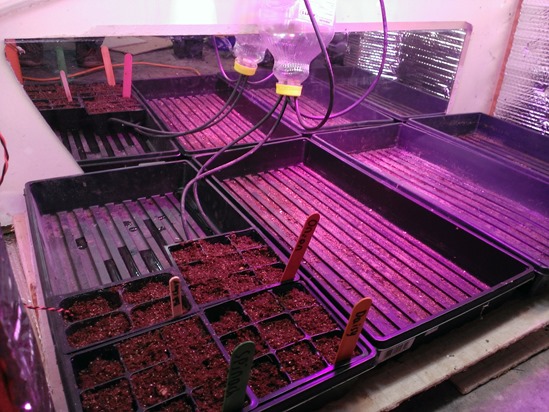
Though it is still pretty cold inside right now is the time for me to begin start planting seeds for this spring. These include bok choy which are very cold tolerant, onions which do pretty good in the cold but could use a head start on these to get some good sized bulbs by the end of the season. I also started some daisies which I will let mature plenty before bring them out. Finally I planted some spinach to try to grow some greens for consumption in my grow box given how much empty space I have in here right now 🙂
For my seed starting mix I start with some coconut coir, though you can find this in the gardening section I typically grab a three pack at the pet store at nearly half the price. Though looks like you can get it at a pretty good price on Amazon these days with free shipping.
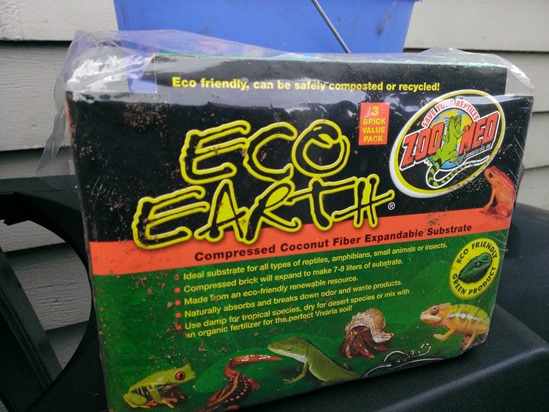
All you have to do is add 1 gallon of water and let sit for a about 10 minutes then still a bit with a trowel.
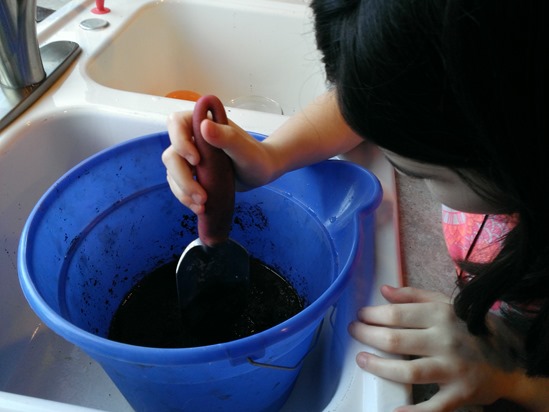
Though this works great by itself as a seed starting medium I typically add a couple cups of vermiculite (to lighten up and moisture control) and a handful organic fertilizer to add some trace minerals to give the seedlings a head start when they emerge.
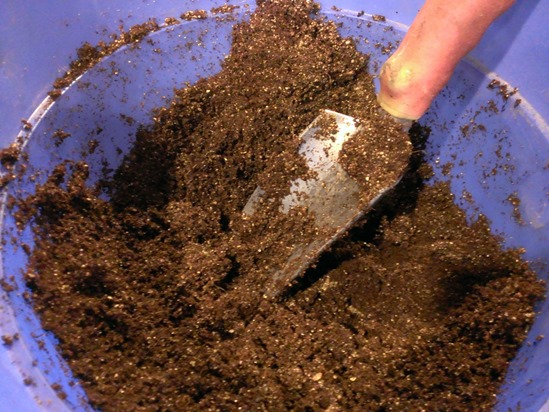
Finally will fill the Name Your Linkplant trays with your seedling mix and add you seeds, not watering should be required since the soil should already be pretty moist.
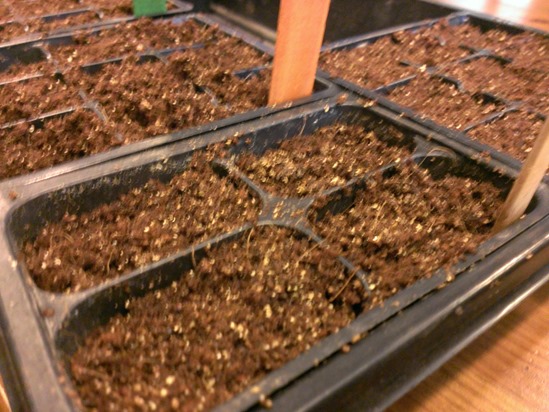
Complete by add some popsicle sticks with some handwritten labels or use a discarded yogurt container from your recycling container to make your own plant labels by simply cutting them into strips like shown below.
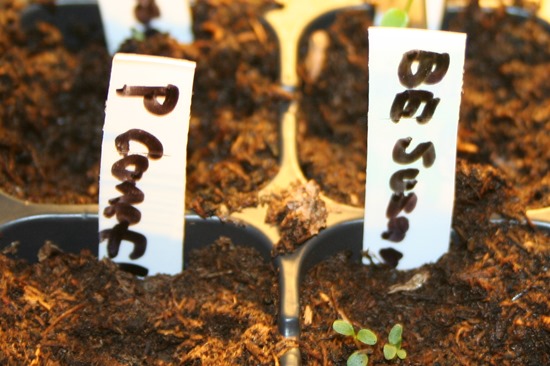
Indoor gardening with 2 liter bottle and USB LED light
11.3 years ago indoor growbox, indoor seed starting, LEDs
I came across this pretty cool Kickstarter from Vegetronix where they are putting together a neat little kit that includes an adjustable 1 watt that can plug into any USB port on your computer. All you need to supply is an old 2 liter bottle and you have a nicely contained growing environment.
Personally, I think this could make an awesome addition to my windowless office and bring a little plant life to my personal space.
If the Vegetronix name sounds familiar, I use their moisture sensors in my grow box which I wrote here.
Things to know before making home garden greenhouse
11.4 years ago greenhouse, indoor growbox, indoor seed starting
There are so many options these days when you decide to own a greenhouse. You can buy a lot of greenhouse structures and modify them or just do-it-yourself. Also there are guides for you to build your own greenhouse. These guides are available on the net, and also on print.
But before you start, you first need to decide on what you need. It is also important to know or understand what you can build and what you want to grow.
Other important aspect that needs to be considered is the expenditure and the climate of your region. Space that you have at your disposal is also one of the key factors. Mentioned below are some of the things you must know before you start your dream project.
1. Location:
Always try to place your greenhouse in such a spot that enjoys a lot of sunshine. It is better that there are no shady trees around. This will have two benefits, during storms the chances of branches falling on your greenhouse is nullified, and shade from the trees will not affect the heating up of your greenhouse. More importantly shedding of the leaves from these plants can prove to be a problem to the greenhouse too.
In case the greenhouse tends to overheat, using a cover or painting it can be good options.
2. Cleaning:
If you are planning to reuse your old greenhouse or even set up your new one, make sure to clean and scrub all windows and glass parts. Also clean the outer surface. Using brown soap for cleaning seems to be the best option. In case you are cleaning the old one make sure to remove insect protections if any before the cleaning jobs starts.
3. Temperature:
The temperature in the greenhouse should range between 77 degrees F (25 degrees C) and 59 degrees F (15 degree Celsius) on the positive side. There can be lots of options to heat your greenhouse, which is very essential for the success of a greenhouse. Electrical heaters, oil or wood fuelled ones are also available with the gas powered ones; but all these heating systems particularly the last three must be ventilated to the outside properly.
These days passive solar green heating options are also available which are very much environment friendly as well. They also have a heat sink which stores the heat and uses it to heat the structure during the dark phase.
The heat needed in the greenhouse is proportional to the size of the greenhouse and also varies with the crops. Consult a professional to help you calculate the proper temperature to be maintained.
4. Ventilation:
Proper ventilation of the greenhouse is extremely important.
Ventilation will circulate air inside the greenhouse and fresh air is necessary for proper plant growth. Stale air is not conducive for proper plant growth.
5. Insulation:
Insulating the greenhouse is very important for it to function properly. The structure need to be airtight in order to bring in the best result.
6. Moisture:
The moisture inside the greenhouse needs to be maintained along with a good drainage. Overwatering and under-watering can both be harmful to the plants. So make sure to have the right amount of water, and a good drainage to ensure that its does not remain water-logged. Automated water sprinklers can be very useful. Rainwater harvesting and recycling can be environment friendly options.
7. Protection:
Protecting the plants from pests and other elements need to be one of the priorities. Make sure to use good quality soil, and treating them before use, and also use pesticides and fungicides regularly. Bio-pesticides and bio-fungicides will help for greener environment.
8. Fertilizers:
Depending on the soil quality and nutrient choose fertilizers. But do not use excessive fertilizers, as they harm the plants much more. Use bio-fertilizers like compost for best results.
Conclusion:
Take into account the climate you live in and choose the crops accordingly. That will save you a lot of pain. Non-heated greenhouse can be fine, but that will only reduce your choice of crops, and the growing season possibly. Try not to make the green house too low, or the roof flat as that may cause unforeseen trouble, as the roof might cave in at some point of time.
About The Author: Alia is a writer/blogger. She loves writing, travelling and blogging. She contributes in Morris Gad
Growing peppers during a cold Pacific Northwest summer
12.8 years ago cayenne, indoor growbox, jalapeno, peppers
Nearly August and I decided it is finally time to bring the peppers out from the garage, though in some ways they are doing so well in the heated grow box with a killer 120 watt Extreme Flower LED lighting not sure if I should chance it but looking at the upcoming forecast this might be as good as it gets.
So far my peppers in the Topsy Turvy strawberry planter appears to be a success. Even with the cold wet summer we have been having plants have survived and even has at least one baby cayenne pepper growing on it.
Though they are just now starting to see their first rays of sunshine have a good looking Rossi Italian Pepper growing here.
Here I have a couple of banana peppers I can pick anytime.
I am also excited to see these jalapeno peppers provided I ran out of jalapeno pepper powder a few months ago and have been missing it in my omelets in the mornings.
Finally I have my cayenne plants which was a survivor from last year, I pulled it into the garage to let some of the last few peppers ripen up as the temperatures got cool and forgot about it. After a few months I assumed it was dead until I saw some new growth on the plant and quickly put it under the LEDs where it fully recovered and started flowering and producing fruit. Currently drying some of the pods and also saving some of the extra mature ones to save for seeds might have a hearty specimen here.




